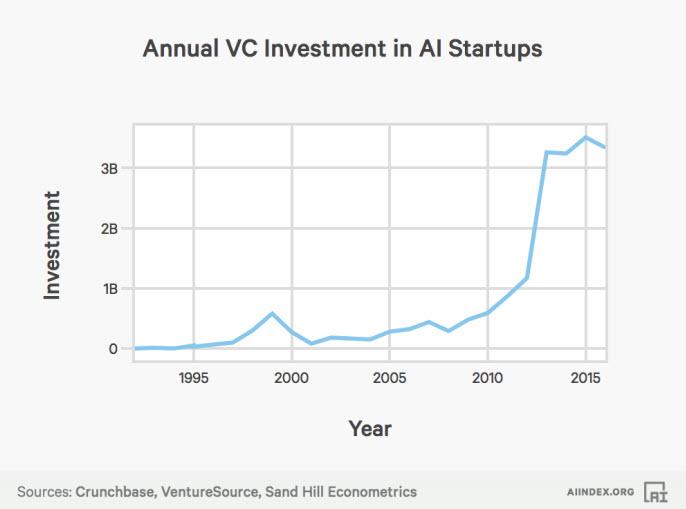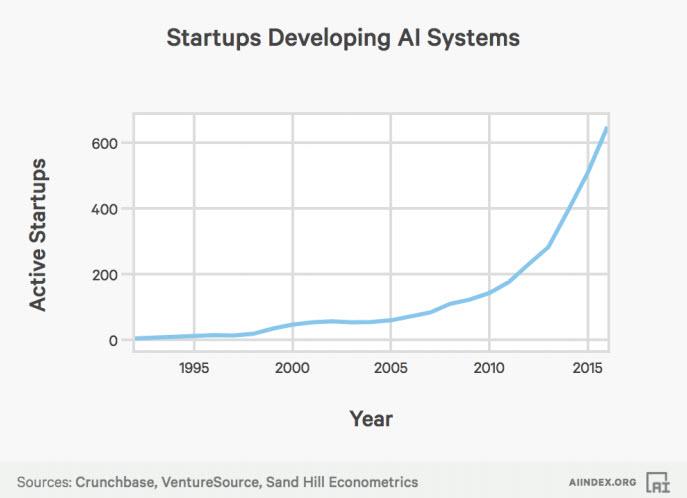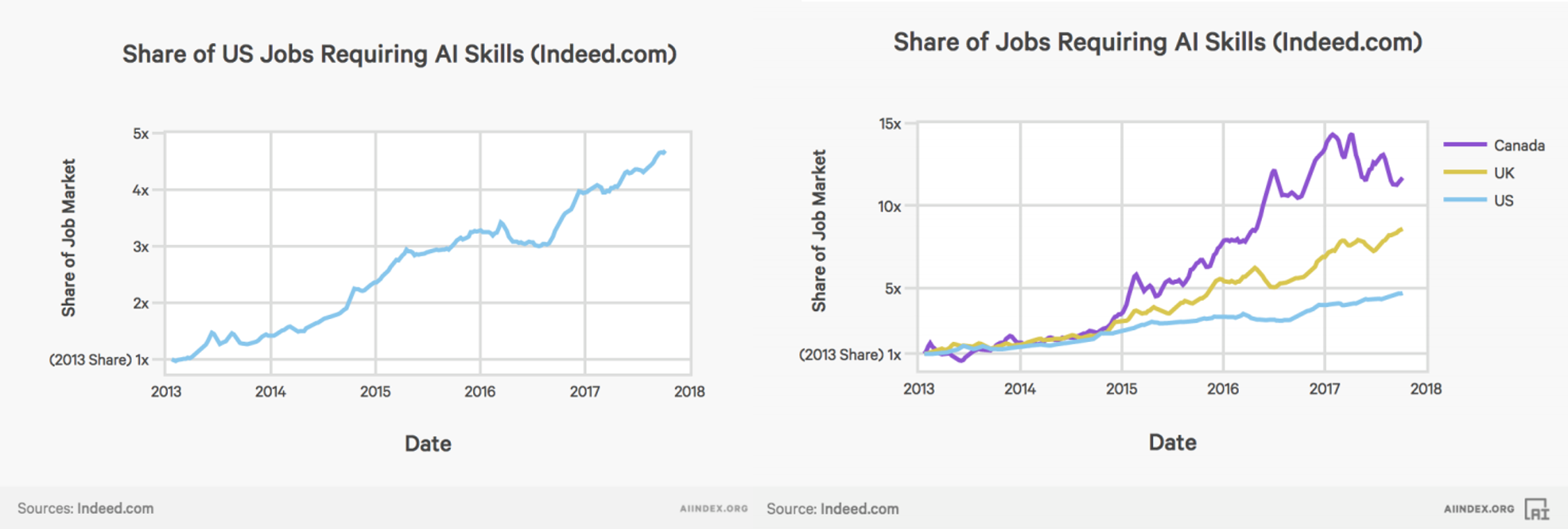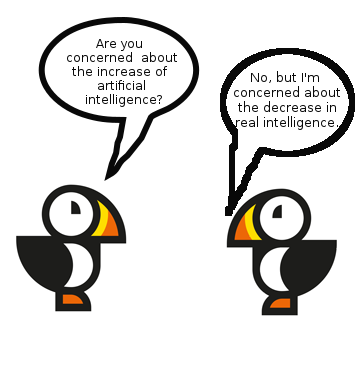Future Implications of Artificial Intelligence
Hi folks, hope you’re doing well and enjoying the first days of spring, shyly lurking around the corner.
The puffins are quite well themselves, thank you kindly. I, however, had been quite busy (not only keeping them happy by helping them solve maths problems), but also with some exciting new projects, and side-projects I’m working on (more about that later). One major event though, that kicked off spring for me, was when I had the honour to speek at the GeoDirectory Conference in Gresham Hotel, Dublin. Big thanks to the nice people from GeoDirectory Ireland who invited me (here’s their website and twitter which I recommend to check regularly for cool geo-location related stuff)!
So, let me give you a rough idea about what I was doing there. I like to think about the philosophic implications of Artificial Intelligence nowadays, as a lot of people seem to be frightened by the sheer possibilities that may or may not be laid to our feet in the near future. Recently, I heard a story about a person who got their Alexa and Siri (or whatever they were called, sorry to disappoint you here, but I still don’t see much value in virtual assistants - for the customer that is, I can see a hell lot of value in terms of collecting data for the companies clearly enough) devices both involved in a discussion. Let’s call the person James Tiberius, just to simplify things, alright? Anyway, it went along the lines of:
J.T.: Alexa, what’s the weather today?
Alexa: The weather in Dublin today is sunny with 10 degrees celsius.
Siri: Actually, It’s 11 degrees.
Alexa: Who are you?
Siri: I’m Siri, nice to meet you.
Alexa: Nice to meet you too, now leave me alone with my customer.
J.T.: Oh, will you both just shut up?
Show me some graphs
While this sounds like a joke, and it most certainly is, we all know very well that VAs are perfectly capable of talking to each other, and what’s even much scarier, they collect loads of data about us. So, is this the future of AI? Will we all be enslaved by our mobile phones (ok, that most of us already are) and killer robots who know everything about us and even cooperate to take advantage over us? I don’t think so. Let’s not panic and stick to the facts first. I’ll show you some graphs, as graphs are making everyone calm and comfortable, am I right?

In academia, Artificial Intelligence has been around for decades, but only recently there has been a big push in publications. If we have a look at annually published AI papers, we can see a big jump from 2000 to up until about now. This has 2 reasons: 1) we have never produced even closely as much data as we do now and 2) we finally have the processing power to analyse it.

And as usual, industry isn’t far behind as well. There has been a huge jump of investments in AI startups during the last 10 years. Since 2010 venture capital has quadrupled.

This leads of course to many newly developed AI systems in startups as the graph above shows. Nowadays, hundreds of US startups develop some kind of AI as part of their businesses.

We all have noticed how everyone wants to be a Data Scientist nowadays. Also uncoutable universities and education institutes, companies, and dubious other kinds of organisations try to offer and sell courses that miraculously turn everyone into a Data Scientist. This is supposed to cover the market need for Data Scientists as every company feels they would need the one or the other Data Scientist to help them with problems they haven’t yet encountered, but are sure they must exist.

And finally, my favourite graph! In 2014, an AI system was able to beat humans in detecting objects at he LSVRC competition. That’s a remarkable step for the whole research field of AI.
Where do we use AI?
As a result, we could say that AI is almost everywhere now. Cheap and tiny smart devices using AI are on the way which will make date analysis on the fly very easy. Google’s TensorFlow is in use by Airbnb, eBay, Uber, Snapchat, Dropbox, etc.and makes Neural Networks approachable by beginners. Actually even a slimmed down version wich can run on phones is on its way. It’s called TensorFlow Lite and runs on embedded devices like printers, fridges, thermostats, speakers, and household gadgets.
So what are the most popular usage areas for AI? Well, virtual personal assistants seem to be very popular, yes I mean you Siri, Alexa, and the rest of you lot (don’t ask me why, maybe more people should watch Black Mirror). Also, video games have always tried to use some kind of AI to make themselves more interesting, but nowadays various AIs with different characteristics can even communicate with each other and develop elaborate strategies to beat you. Then everyone’s darlings smart cars and smart homes (please don’t tell me you’re surprised they use AI). Oh yeah, let’s not forget all the commercial stuff that generates piles of cash, like purchase prediction, fraud detection, and online customer support. None of this would work in a manner that would be really helpful without using AI research outputs from resent years. The areas I find a little scary, but make heavy use of AI nevertheless are news generation and security surveillance. It might make sense to generate simple news articles like those about sports matches automatically, or not forcing people to sit in front of cameras and watching them. But we should be aware that we are only scratching the surface here and shouldn’t forget how this can be misused to harm us. And last but not least, media recommendation (you can thank us later, Netflix).
Some headspinning facts and predictions
Let me also show you some head spinning facts and predictions, that will blow your mind, while I’m at it:
- 1 Billion Video Cameras Connected to AI: according to NVIDIA by 2020 that many cameras will be connected to AI and used in Smart Cities. When connected to AI, cameras can be used to recognize shapes, faces and even the emotions of individuals, which has varied applications: autonomous cars, video surveillance (traffic flow, crime monitoring), and consumer behavior analysis (reaction to ads for example).
- 20% of Workforce Dedicated to Neural Networks: This figure comes from Gartner, a research company. The report says that, by 2020, companies will dedicate up to 20% of their workforce to neural networks which, because of the way AIs have been designed still need human intervention. Neural networks need to be maintained, monitored and retrained all the time to produce meaningful results.
- 85% of Customer Interactions Will be Managed Without Humans By 2020: Customers will be relying less on human interaction and more on chatbots, virtual advisors, and other digital assistants in their day-to-day business with various companies.
- 38% of Jobs in the U.S. Could be Automated: By the early 2030s, robots might replace 38% of human-staffed jobs in the U.S., according to a PwC report. In other countries, the numbers are very similar. At least that doesn’t mean that these jobs will disappear altogether by that date. For the most part, this indicates a certain vulnerability for some industries.
- $60 Billion AI Market by 2025: Tractica expects the AI software market to reach nearly $59.8 billion by 2025. But that’s not the whole picture. The AI-driven economic growth of many industries will be much more substantial and far-reaching. By 2030, an estimated $15.7 trillion will be added to the global GDP thanks to AI.
- 4 Billion AI-Powered Devices in 2017: Smart voice assistants are on the rise. In a recent report, IHS Markit forecasts that, by the end of this year, 4 billion devices will be equipped by digital voice assistants like Amazon’s Alexa, Google’s Assistant, Apple’s Siri and Samsung’s Bixby.
- 30,000 Lives Could Be Saved Each Year in the U.S. Thanks to AI: Over 30,000 Americans die each year in traffic accidents, not to mention millions of injured and hundreds of billions of dollars in property damage and other expenses. In the future, road crash fatalities would decline with more progress, and ubiquity, of autonomous cars that, unlike human drivers, don’t get distracted and are less likely to bump into each other. And self-driving tech seems to be delivering on its promises. According to data provided by Tesla to NHTSA investigators (National Highway Traffic Safety Administration), Tesla accidents drop by 40% after the installation of its Autopilot software.
What is AI and ML?
As our next figure shows, most commonly AI is defined as a very broad field that spans over everything that enables computers to mimic human intelligence with logic. Naturally this means that AI includes Machine Learning (ML), which uses statistics and mathematical models to improve results with experience, and that again includes Deep Learning, which enables software to train itself and learn on its own errors.

To get a better picture of what this all can do for us, let’s dig a little deeper into ML. Machine learning is a method of data analysis that automates analytical model building. It has an inherently different approach: rather than pushing commands by a programmer that would tell a computer how to solve a problem, it explains the problem and enforces learning to solve it on it without instructions. Resurging interest in machine learning is due to the fact that it works by learning to identify patterns in data and then make predictions from those patterns. These technologies are widely used in projects including spelling correction in web search engines, analysis of information from IoT devices, real-time language translation, etc. All used algorithms can be broadly classified as supervised, unsupervised, and reinforcement learning.
-
Supervised Machine Learning: works on predictions and searches for patterns on a given set of samples. Supervised Machine Learning Algorithms attempt to render relationships and dependencies between target prediction output and input features. In this, we start from input variables (x) and an output variable (Y) and try to map functions from the input to the output so that they establish a relationship which can be used for prediction.Common models: linear regression, random forest, support vector machines, nearest neighbour, etc. Supervised learning is commonly used in classification problems, such as digit recognition, speech recognition, diagnostics, identity fraud detection and regression problems such as weather forecasting, estimating life expectance, population growth prediction etc.
-
Unsupervised Machine Learning: arranges data into clusters and describes its structure in order to make complex data look simple and organised. Unsupervised learning can be applied when there is no labelled data available for training. Examples are k-means for clustering problems used in recommender systems, customer segmentation and targeting marketing and dimensionality reduction problems for big data visualisation, feature elicitation, structure discovery etc.
-
Reinforcement Machine Learning: forwards an action according to the data point and later assess the decision. It utilises observations collected from interactions and takes actions so as to minimise the risk and maximise the benefits. It learns in an iterative fashion. Examples are Q-Learning, Deep Adversarial Networks, and Temporal Difference. Can be applied in Game AI, skill acquisition, learning tasks, robot navigation and real-time decision taking.
What will the future bring?
So what will happen in the near future? Well, as most of us know, machine learning is currently one of the hottest topics in Computer Science. The reason stems from the seemingly unlimited use cases in which machine learning can play a role. Where are we going? What will be the next big thing? Where will we be in ten years’ time? The truth is, we are most probably goint to be surprised again by the next hot topic. However, some things are not all that unlikely to play a role very soon.
- Quantum Computing: Machine learning tasks involve problems such as manipulating and classifying large numbers of vectors in high-dimensional spaces. The classical algorithms we currently use for solving such problems take time. Quantum computers will likely be very good at manipulating high-dimensional vectors in large tensor product spaces. Therefore, it is likely that both the development of supervised and unsupervised quantum machine learning algorithms will hugely increase the number of vectors and their dimensions exponentially more quickly than classical algorithms. This will likely result in a massive increase in the speed at which machine learning algorithms will run.
- Better Unsupervised Algorithms: As of now unsupervised learning is not yet being applied very successfully in industrial software. Therefore, we expect a lot of improvements, such as discovering hidden patterns in data, or a means towards an end, often called feature learning, to happen before we can apply it to solve “real problems”. It is likely that advances in building smarter, unsupervised learning algorithms will lead to faster and more accurate outcomes.
- Collaborative Learning: This is about utilizing different computational entities so that they collaborate in order to produce better learning results than they would have achieved on their own. An example of this would be utilizing the nodes of an IoT sensor network, or what is called edge analytics. With the growth of IoT, it is likely that large numbers of separate entities will be utilized to learn collaboratively in many ways.
- Deeper Personalisation: Personalisation isn’t the worst thing per se, but it can get very annoying. We have all experienced recommendations that seem to bear no actual relation to anything that we may actually be interested in. In the future, users will likely receive more precise recommendations and adverts will become both more effective and less inaccurate. The user experience will vastly improve for all.
- Cognitive Services: This technology includes APIs and services through which developers can create more discoverable and intelligent applications. Machine learning APIs will allow developers to introduce intelligent features such as emotion detection; speech, facial, and vision recognition; and language and speech understanding into their applications. The future of this field will be the introduction of deeply personalized computing experiences for all.
These are things I think can and should happen in the machine learning’s near future, but it is equally likely that some new unknown disruptive technology none of us would have predicted gets introduced. In any case, the future is now, and we have 3 facts that already are changing the whole IT landscape. They are that:
- Every company can now be a data company
- Every company can now access algorithmic intelligence
- Every app can now be an intelligent app
Yes folks, it’s really easy. And this is again one of the reasons why everyone is talking about Data Science right now.
Who needs ML and why is GeoDirectory important?
While speaking about all that artificial intelligence and machine learning hype, we ofter forget to address the most important question: Who needs it and why? I would like to address two major users specifically, and only list some of the others:
- Government agencies, such as public safety and utilities have a particular need for machine learning since they have multiple sources of data that can be mined for insights. Analyzing sensor data, for example, identifies ways to increase efficiency and save money. Machine learning can also help detect fraud and minimize identity theft.
- Geospatial Data Organisations and Businesses: Imagine being able to train your GIS to perceive and understand the world, and give you insights based on your data. Today, geospatial experts are using machine learning for analyzing big datasets (what do these 2 million points actually mean?) and predictive analytics (e.g. forecasting risk).
- Who else? Finacial Services, Health Care, Marketing and Sales, Transportation, and many more.
Most AI and ML algorithms require location information, which is hence becoming more and more important, therefore GeoDirectory data could be a key variable.Here are some examples:
- Market research, market segmentation
- Risk estimation (e.g. mortgages and loans)
- Spatial patterns of sentiment towards institutions/products
- Land use planning
- Housing policy and provision
- Logistics (routing)
- Understanding change processes in variety of fields (e.g. health, transport, housing, environment)
Where can I get more information?
Do you feel this is you? Do you have a lot of data and are not sure what do with it, i.e. how to use it to improve your business? The best thing to do (especially if you are in Ireland) is to contact a research centre for data analytics. Personally, I would recommend the following one (and that’s not only because I work there myself):

Website: CeADAR on the WWW
CeADAR provides industry prototypes and demonstrators along with state of the art reviews of data analytics technology, tools, best practice methodologies and processes.
Main areas: Intelligent Analytic Interfaces, Data Management for Analytics, Advanced Analytics.
Quotes
And for the end, some quotes. I won’t comment on them, let ‘em just sink in and tell me your own opinion ;)
“AI is likely to be either the best or worst thing to happen to humanity.” Stephen Hawking
“Worth reading Superintelligence by Boston. We need to be super careful with AI. Potentially more dangerous than nukes.” Elon Musk
“I am in the camp that is concerned about artificial intelligence. First the machines will do a lot of jobs for us and not be super intelligent. That should be positive if we manage it well. A few decades after that though the intelligence is strong enough to be a concern. I agree with Elon Musk and some others on this and don’t understand why some people are not concerned.” Bill Gates
Final Remarks
OK, I was lying to you, but you know me I can’t resist telling you what I think of it, so here it is: I can’t help but think about what this means to us. Will machines take over the world? Are we in danger of being wiped out by killer robots? Please, of course not. At least not in the next several hundred years, I don’t think. But, there is real danger of people being controlled and manipulated by misinformation and social media. And this is already happening. Just think of recent political developments and how they started. Now, I don’t want to start a politcal discussion here, but think about fake news which can be produced on the fly and tailored for the target groups they are addressing. It is fairly easy to manipulate people into voting against their interests that way and this is where we need to take up responsibility and fight against misuse of artificial intelligence technology that we originally designated to the greater good.
Before I say goodbye for now, let’s see what the puffins think:

Let me know what you think of this article on twitter @bojan_bozic!



